



No further words necessary…….
Using jigs can be very productive but too many anglers aren’t fishing them correctly. Just starters, understand that you won’t always feel the thump of a walleye when it strikes a jig.
Guys expect that sure bite or hit. Many times you don’t feel it. So often you drop the jig down and it stops. Maybe you’ll just feel some extra weight.
Concentrate on your rod, and don’t wait too long to set the hook.
The right rod helps here. When jigging, use a 6-foot, 8-inch or 7-foot rod when jigging with a light-action and fast tip. This really helps increase the number of bites he detects, which translates into more fish.
Use a short shank jig for live bait and a long shank jig when combining that live bait with a dressing. The latter can be plastic, Gulp, or maribou. If you face a tougher bite, use less bulk and movement in the water. Don’t vibrate your offering as much. Listen to the fish to extrapolate their mood, then up size or downsize properly.
Under most conditions, avoid stinger hooks. If you’re missing strikes, however, and want to try a stinger, use it properly. Just let it free-fall behind the lure.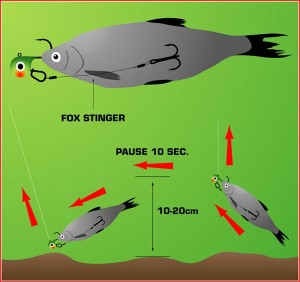
You get fewer bites with a stinger, so if you’re missing fish, drop that rod tip first, and let them take it.
As for jigging actions, think beyond just lift-drop. That’s fine if it’s producing, but often just holding it at one depth, say 3 inches off bottom, is enough. Let that minnow work.
If you want to get creative, try quiver jigging (gyrating the rod ahead of the reel), snap-jigging, dragging, or just casting and retrieving jigs.
Also, use a heavy enough jig to contact bottom, but not so heavy that fish blow it out. Vertical jigging should offer just the right weight to tick the bottom.
And if you feel a bite, set the hook hard. Really swing that rod tip up. Always tie your jigs directly to the line. Suspend it periodically out of the water and let it unravel to eliminate line twist and tangling.
Follow our HUNTING BLOG
 All dedicated walleye anglers seek to catch a 10+ lb. walleye, considered by many, a once-in-a-lifetime prize catch. To accomplish this task one must recognize the variety of waters that yield big walleye, using the proper fishing presentations and fishing the best times of the year which increase your chances of landing that trophy walleye.
All dedicated walleye anglers seek to catch a 10+ lb. walleye, considered by many, a once-in-a-lifetime prize catch. To accomplish this task one must recognize the variety of waters that yield big walleye, using the proper fishing presentations and fishing the best times of the year which increase your chances of landing that trophy walleye.
Walleyes in the North tend to have a much longer life span even though their growth rates are not as high as in the South, but the North still produces many more walleye of 10 lb. plus.
Large walleyes are exceedingly cautious and wary, if they hear or feel anything unusual they stop feeding and head for deeper water. This why only 2 of 1000 walleyes reach this magic 10 pound size. Our guides know this and use big fish strategies that result in catching many huge walleyes annually.
Big Water Big Walleye:
When considering trophy walleye waters big is best, a large body of water (5000 acres+) like Wawang Lake is more likely to support big walleye populations than smaller lakes (500-1000 acres). Competition for food, living space and angling pressure reduces the possibility on smaller waters for walleyes to achieve trophy status.
Large lakes provide an abundance of usable forage (minnows and lake herring), open space and due to large size angling pressure is reduced.
Best Times to Catch Trophy Walleye:
There are four major periods during the year when the odds increase to catch a trophy walleye, however we will only describe three of them since Wawang Lake has no winter fishing pressure:
Spring
Pre Spawn: During the pre-spawn period, large numbers of big females stage into a relatively small area. Although they are not feeding aggressively, you may be able to catch a fish or two due to the sheer numbers present. The pre spawn bite is good until spawning begins.
Post Spawn: A few weeks after spawning the big females recover from and start to bite again but finding them is difficult as they are scattered. You may catch an occasional large walleye, but seldom more than one. Your chances of finding a concentration of big walleyes are much better after they have settled into their typical deeper water summer locations. The best fishing begins about five to six weeks after spawning and generally lasts two to three weeks.
Fall
Late-fall: Fishing is unpredictable, the toughest part is to locate the walleye, but if you do find them a high percentage will be big. The majority of large walleyes caught in late fall are females. Their feeding for the development of eggs for the spring spawn, females must consume more food than males, up to six times more according to feeding studies.
Winter
Wawang Lake has no winter pressure (fishing) and therefore our fisheries remains healthy with strong genetics and lineage.
In waters that stratify, after the fall turnover is completed the depths are warmer than the shallows. Big walleyes may swim into shallow water for short feeding sprees in the evening, but during the day they may be found as deep as 50 feet. Although difficult to find, they form tight schools, so you may be able to catch several from the same area.
Trophy Walleye Presentations:
Locating big walleyes is half the equation and other half is the proper fishing presentation. Here are a few tips to help you land big walleyes.
The first and most common mistake made by anglers is noise, whether it be dropping the anchor on top of the fish, running the outboard over the spot you wish to fish or dropping anything in the boat while fishing.
Most often large female walleyes will relate to a piece of structure similar to the smaller males, but will hang 10 to 15 feet deeper this is attributed to a walleye’s increasing sensitivity to light as it grows older. In addition, bigger walleyes prefer cooler water, and they can usually find it by moving deeper.
Increase your chances for big walleyes by fishing in the shallows during low-light periods, especially in spring and fall. If the water is very clear, or if there is a great deal of boat traffic, big walleyes will feed almost exclusively at night. During the daytime they prefer relatively deep water, deeper than the areas where you typically find smaller walleyes.
In deep northern lakes, the shallow water temperature stays cool enough for big walleyes through the summer. If the walleyes can find boulders or other shallow-water cover to provide shade from the sun they may spend the summer at depths of 10 feet or less. In these lakes, most anglers fish too deep.
Increase the size your live bait or lures, they maybe too small to interest a trophy walleye. Many times large walleyes are caught on musky/pike baits in the 6″ – 8″ range. Larger baits will draw far fewer strikes than small ones, and
most anglers are not willing to fish all day for one or two opportunities. But if you are intent on catching a trophy that is the price you must pay.
 |
Big walleyes are extremely cautious, especially in clear water. You don’t need to over-rig your set-up. They’re more likely to take a bait using a size 6 hook using 6-8lb test line than 12-17lb test with a 1/0 or bigger hook. A small hook will allow the walleye to swallow the bait without feeling anything unusual and will not pull-out or break. Most large walleyes are caught away from snags and take your time to bring the fish in allowing the rod, reel and drag to do its job.
Follow our HUNTING BLOG
WEB RATES FISH HUNT CABINS PHOTOS
TESTIMONIALS BROCHURE HUNT BOOKLET
4 lbs. northern pike fillets, de-boned, cooked and chopped
4 Potatoes, boiled, mashed
2 Eggs, beaten
8 Green Onions, chopped
Salt & Pepper
1/2 Green Pepper, chopped
1/4 tsp. Tabasco
2 cloves Garlic, minced
1 cup Flour
Spray Oil for frying
Mix ingredients well and shape into patties. Dip the patties into the flour and fry until browned in a non-stick fry pan sprayed with oil. Great meal with fresh caught fish or left over fish too.
Follow our HUNTING BLOG
WEB RATES FISH HUNT CABINS PHOTOS T
ESTIMONIALS BROCHURE HUNT BOOKLET
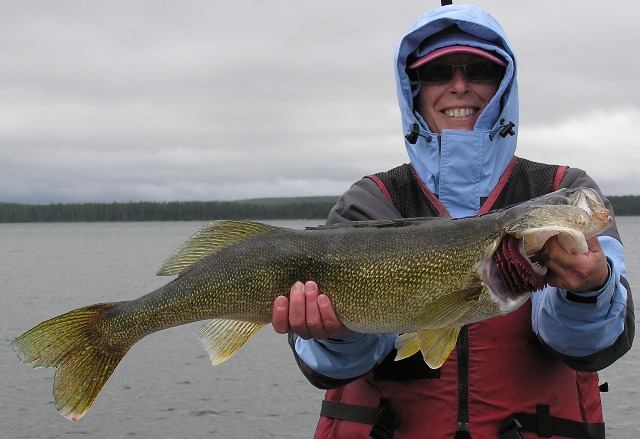
If hooking a big walleye is the plan then Wawang Lake is where you want to go whether it’s spring, summer or fall . While walleye are rather active and generally numbers are much easier to find during the spring, but catching BIG trophy sized walleye happens all season long. Catching these big guys still takes some tactics to reel them in. If the plan is to drop a line, hook a fish and go home happy within a few minutes, the outcome could be disappointment.
Although springtime is the favorite for walleye fishing, anglers need to keep a few things in mind. Everything from actual weather conditions to location and bait can impact the outcome of a fishing trip. The trick is really gauging the action carefully before picking a spot to stay at. Walleyes like water between 55 and 68 degrees Fahrenheit, and they move to follow it. In spring you’ll find them in the shallows of lakes and fall they will move into shallower water depending on light and wave activity.
Location Matters in The Spring
 When the waters are thawing, but haven’t turned warm just yet, the shallows are generally the place to go. Anglers often quickly find a few key spots that work very well in the spring months.
When the waters are thawing, but haven’t turned warm just yet, the shallows are generally the place to go. Anglers often quickly find a few key spots that work very well in the spring months.
It’s important to keep in mind that changing weather patterns can affect where walleye happen to be on a particular day or night. Many anglers swear by very shallow, night fishing to catch walleye during the cooler spring days but this is not always true. Slightly warmer, less windy days might find them a little further out though.
Spring is typically the one of best times of year to hook a winning walleye, but that doesn’t mean the prospect will always be easy.
The temperatures this time of year, especially in early spring, can be brutal on anglers. Exercising a bit of patience, finding the right spots and paying heed to weather patterns can make a difference.
Remember, the landscape can change from day to day. On cooler days (or nights), they are often found very close to shore, but mid-level areas might hold them when the temperatures start to turn up just a bit.
Follow our HUNTING BLOG
WEB RATES FISH HUNT CABINS PHOTOS
TESTIMONIALS BROCHURE HUNT BOOKLET
Bait Casting
Bait casting is a style of fishing that relies on the weight of the lure to extend the line into the target area. Bait casting involves a revolving-spool fishing reel (or “free spool”) mounted on the topside of the rod. Bait casting is definitely an acquired skill. Once you get the hang of the technique (check out the casting animation), you will be casting your lures right on target into the structures where fish are feeding and hanging out.
With bait casting, you can use larger lures (1/2 to 3/4) and cast them for longer distances. To get started, you’ll need a rod with good spring action, a good quality anti-backlash reel, 10 to 15 pound test line and a variety of specific bait casting lures.
Spin Casting
We won’t say it’s foolproof, but spin casting is an ideal fishing method for beginning anglers. Spin-casting equipment is easier to use than bait casting. You can use it to cast both light and heavy lures without tangling or breaking your fishing line. Basic equipment includes a 7-foot rod, a spinning reel and 6 to 10 pound test line for casting 1/16 to 3/4 ounce lures. You can use an open-face, closed-face or spin-cast reel for spin casting.

Trolling
Trolling is done using a small electric motor that moves the boat quietly through the water so fish aren’t spooked. But you can also troll by towing a lure while walking along the edge of a shoreline, bridge or pier. The speed of the boat determines the depth of your bait. And the depth of the bait is determined by the species of fish you’re trying to catch. Use a spinning reel or a bait caster for trolling. Some states don’t allow motorized trolling, so check out your local fishing regulations to avoid tangling with the fish enforcers.
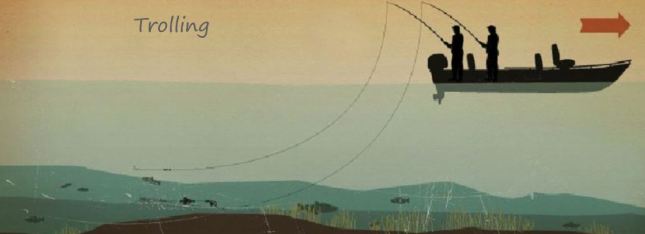
Still Fishing
Still fishing is a versatile way to go. You can still fish from a pier, a bridge, an anchored boat or from shore. You can still fish on the bottom or off the bottom in ponds, lakes, rivers and streams for a variety of species. And you can still fish during most seasons and during any part of the day. Your equipment and the size of the hooks and bait you use depends on what kind of fish you’re after. But your best equipment for still fishing is patience. You have to wait for the fish to bite.

Drift Fishing
Drift fishing allows you to fish over a variety of habitats as your boat drifts with the currents or wind movement. You can drift fish on the bottom or change the depth with a bobber or float. Natural baits work best. But jigs, lures and artificial flies will produce good results, too. You can drift fish on ponds, lakes, rivers and streams any time of the day and year.

Live Lining
Your fishing line is “live” when your boat is anchored in a flowing body of water like a river or stream. Use live or prepared fishing bait and keep it on or just off the bottom. Live lining off the bottom allows your line to drift with the current through holes and rocks where the fish may be holding. Your equipment and the size of your fishing hooks and lures depend on what type of fish you’re after.

Chumming
To attract fish or get them biting again, you can throw “chum” into the water where you’re fishing. You can use ground-up bait fish, canned sweet corn, dead minnows in a coffee can for ice fishing, pet food, even breakfast cereal. Or stir up some natural chum by scraping the bottom with a boat oar. Be sure not to over-chum. You want to get them interested in feeding; you do not want to stuff them before they get a chance to go after your hook. Chumming is not legal in all states. Check local fishing fishing regulations to make sure you are not illegally stimulating the hunger of your future catch.
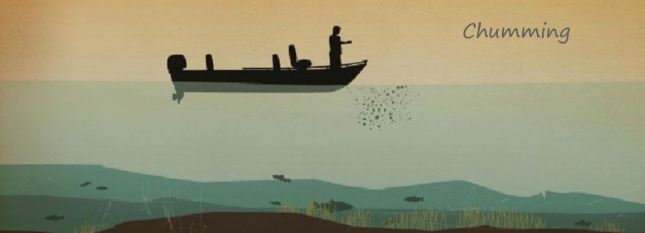
Bottom Bouncing
Bottom Bouncing is done from a drifting or trolling boat, and it’s a great way to attract or locate fish during most seasons and times of day. Use a buck tail jig or natural bait and drag it along the bottom. The dragging motion causes the lure to bounce along stirring up small clouds of sand or mud. After a few strikes with bottom bouncing, you can drop anchor and apply other methods to hook the particular kind of species you’ve attracted.

Vertical Jigging
Jig fishing is popular and challenging. Why? Because the person fishing is creating the action that attracts, or doesn’t attract, the particular type of fish he or she is trying to catch. Here’s how it works. Cast out and let your jig hook sink to the bottom. Then use your rod tip to raise the bait about a foot off the bottom. Then let it drop back to the bottom. You can jig up and down, side to side or up and down and sideways. Jig rigs come in all sizes, shapes and colors, and can be used with or without live fishing bait.

Jig & Live Bait (minnow, leech or worm)
Attach the live bait to your jig hook and use it to bottom hop or sweep through your target area. To bottom hop, cast to the target and let the jig sink. Then reel in slowly, twitching the rod with every third or fourth turn of your reel. To sweep, cast to the target and drag the jig parallel to the bottom while reeling with a fairly tight line. Slow and steady gets the fish when you’re sweeping with a jig and live bait.

Surface Poppers
There’s nothing quite like the sudden, exciting rush of a fish rising to the surface and exploding onto your lure. Surface poppers are a style of top-water fishing bait that get their action from a cupped face carved or molded into the front of the lure body. Cast your popper out to the target area and let it settle briefly. By taking in small amounts of line slowly, the cupped face “pops” along the surface, imitating the action of prey, such as small insects, small frogs or even a small injured fish. To increase your chances of landing your catch, resist the urge to set the hook immediately when the fish strikes – let it take the popper under the water first – then set your hook firmly.
Using Spoons
Spoons are among the most popular lures and are easy to use. Some are thin and light, some are thick and heavy. And different spoons have different actions. How and where you’re fishing will determine how to use them.
Casting spoons: The basic technique is to cast it out and reel it back. A steady retrieve is usually best. If fish are curious but not striking, try slight variations in the speed or direction of your spoon.
Trolling spoons: Thinner and lighter than casting spoons so they can be trolled slowly. Typically used with depth control rig for open water species like trout, salmon or walleye. Can also be tied onto a rig with a diving crankbait and trolled on a long line to go after species near the bottom.
Topwater/Weedless spoons: Great for predators like bass, musky and pike that tend to hide in thick underwater cover. Cast over the cover, start retrieving and reel just fast enough to keep the lure on the surface.
Jigging spoons: Great for predators typically found on deep structure. Let the spoon freefall down. When it hits bottom, take up slack line until the rod tip is a foot above the water, then work the spoon with short jerks up and down. Usually, strikes occur when the spoon is falling, so be ready.
Follow our HUNTING BLOG
Vertical jigging can be an invaluable technique, especially when it is placed into the mix with trolling, casting and static-line methods. It can be another powerful weapon in the angler’s arsenal, but, unfortunately, it is perhaps not used as frequently as it should be.
The advocates of vertical jigging state that not only is it a fun-filled way to while away the hours, but it is also a highly productive way to fish. Many anglers dramatically increase their success rate when they begin to use a vertical jig.
In fact, in some locations, vertical jigging is not simply one of the beneficial tactics, but it is the most productive method of fishing for walleye. The advantages of vertical jigging are numerous. For example, it is widely accepted as a cost-effective technique. In addition, it only requires a small amount of physical exertion and, most importantly, it is a basic approach that can be adopted by anybody.
 The success of vertical jigging is made possible through the accuracy of the technique. Rather than trolling wide expanses of water, it is required that the angler does a little research first. By establishing the structure of the lake or river that you are fishing in, you can locate the positions that are most likely to contain the walleye. Of course, if you have radar equipment, then you will find pinpointing the walleye spots even more easy, but this is not necessary and a comprehensive map of the water should be sufficient.
The success of vertical jigging is made possible through the accuracy of the technique. Rather than trolling wide expanses of water, it is required that the angler does a little research first. By establishing the structure of the lake or river that you are fishing in, you can locate the positions that are most likely to contain the walleye. Of course, if you have radar equipment, then you will find pinpointing the walleye spots even more easy, but this is not necessary and a comprehensive map of the water should be sufficient.
There will be times when establishing the position of the fish leads you to the deep sections of the lake or river. If you are fishing for walleye in particularly deep waters, you may wish to consider using a partial glow head and spinner blade on your jig, as this is a great combination for deep fishing or trolling.
In terms of bait, when it comes to vertical jigging it really is a matter of choice. Any bait can be used, so, if you find that minnows, crawlers or leeches work best for you then, by all means, use any of those. Personal preference is such a large part of successful fishing.
More good news for beginners is that vertical jigging can allow for a margin of error. In other words, if you have let a walleye get away, but you know it is still  under your boat, the vertical rig allows you to get right under the boat to try for a second chance. With many presentations, you may not expect to get a bite until the bait has reached the lakebed. However, with the vertical jig, you are just as likely to find success as the bait is on its way down. Subsequently, it is always a good idea to be prepared for those walleye.
under your boat, the vertical rig allows you to get right under the boat to try for a second chance. With many presentations, you may not expect to get a bite until the bait has reached the lakebed. However, with the vertical jig, you are just as likely to find success as the bait is on its way down. Subsequently, it is always a good idea to be prepared for those walleye.
Vertical jigging, or V-jigging as it is sometimes known, is an extremely enjoyable way to fish. It relies heavily on skill and technique, which is hugely satisfying for an angler. However, that does not mean to say that it is difficult to learn. Even beginners can take to vertical jigging and can be extremely successful with this method
Follow our HUNTING BLOG
WEB RATES FISH HUNT CABINS PHOTOS
TESTIMONIALS BROCHURE HUNT BOOKLET
Here is a short video with some helpful tips and reminders so that you will get to your destination safely so that you can enjoy your fishing vacation without worry.
Follow our HUNTING BLOG
There are three times during the open-water period that can be considered prime for big pike.
Each of these windows of opportunity lasts from 10 to 14 days and is key for large-sized northern because during this time, the bigger fish of this species are more concentrated in the shallower water. Here’s where they can be found easily and caught with lures that allow anglers to cover some ground in their search. Once these big pike head to the cool depths where they spread out and suspend, finding and catching them requires tremendous amounts of luck. It’s better to time your fishing for big pike to these three periods to take advantage of factors that give the edge to the angler instead of the pike.
Right after ice-out, you find huge northern pike in the spawning areas. These will be shallow weed-choked bays in the lake, and weedy backwater bays up the river.
Little northern aren’t hard to find and catch, but the big pike are a challenge and they put up one heck of a fight. When you hook into a really nice pike, you can’t make any mistakes.
Don’t let the cold water temperatures right after ice-out deter you from using an approach that allows you to cover some ground. This is the perfect time to be tying on a spinner bait because it’s a lure that works well in shallow vegetation.
The pike move up into whatever vegetation is still standing from the previous year — and any newly emerging weed growth that can often be found in very shallow depths. Use a 3/4-ounce spinner bait with a large Colorado blade. This lure casts a long way and can be retrieved slowly, if that’s what’s necessary. You can also burn it a little faster just below the surface in the real shallow water.
Some of the pike will have already spawned, more than likely while ice still covered the surface. Others are still spawning or are preparing to. Occasionally you may catch a big pike and you can tell is post-spawn, most of the really big pike after the ice has just gone out are still fat with eggs and just on the verge of spawning. All trophy fish are released back to Wawang Lake.
It’s the transition period when the shallow shoreline regions are warming and the big northern are moving into the deeper, cooler water when most anglers get their first shot at big pike. This period usually falls into a two-week time frame a couple of weeks after the traditional opener. Anglers who can be on the water at this time can capitalize on big fish that are still in reaching distance for a spinner bait or crank bait.
It’s no secret that big pike like the colder water. You will seldom find the bigger pike in the shallower regions in the lake during the summer months, because the water temperatures there are just too warm for their liking. If you miss this transition period, you’ll likely be into fall before you get another chance at a really big pike, because those bigger fish get hard to come by when they disappear into the depths.
This is a good time to get out Spoon plugs. Any lake that has a well-defined deep weed line is a perfect candidate for Spoon plugs.
The Spoon plug is a lure that was promoted years ago by famous angler Buck Perry, and is a staple of many diehard big-pike anglers. It allows an angler to troll a weed line or break line precisely at speeds of 1 to 4 mph.
You can cover some ground and find out where those pike are, although during the transition, it’s more important to have your lure in the right place than worrying about the speed. Those Spoon plugs will get the lure to the right depth and stay on the weed line, no matter what speed I find triggers the bite.
So how does an angler know when the transition starts and ends? Water temperature signals the start. When the surface temperature hits about 67 degrees, you know it’s going to start pushing those fish out. This could be early June during some years and early July in others. The weather is the biggest determinant in when this transition period occurs.
You can tell it’s over when the fish quit the bite. You’ll have a week where the weed line and shallow rock piles are producing big pike with some consistency, then one day you go out there and they’re gone.
The pre-turnover period is when those big pike come out of the deep water as the shallow water cools, just prior to the lake rolling over.
Turnover is a tough time to call, which is why the guys who can get out on a body of water often generally hit this time just right. If you miss it, then there is a period for a couple of weeks after turnover when the fishing is tough all over a lake. It’s just luck and timing.
The big pike will be roaming over the tops of the vegetation, you’ll just want to be ticking the tops of the cabbage, coontail or milfoil with that spinner bait, and if the blade is just a nice slow thump, that’s perfect.
Back troll slowly over the vegetation, with only about 25 to 35 feet of line out — the line from the reel at a 45-degree angle toward the lure and the spinner bait right above the vegetation. By wearing a good pair of polarized glasses, an angler can watch the bait as it dances in and around the stalks and branches. As the boat moves from shallower to deeper water, drop the rod tip or lets out a little more line until the lure starts ticking weeds again.
If seeing an opening in the weeds, drop the rod tip and let the lure settle in. It’s amazing how often you see the big pike react to the spinner bait and come out of a big pile of milfoil or coontail and attack that lure.
These big pike are the top predators in a lake and they fear nothing at this point. You’ll see them swim right into the prop wash to hit a spinner bait or spoon as it’s trolled out from the boat.
Back trolling allows more depth control. It’s easier to get the speed down and work a depth more thoroughly when backing the boat. If the pike are deeper switch to crank baits or Spoon plugs, then front-troll. But when pulling spinner baits over the tops of the weeds, back troll.
Open-water season in northern Ontario lasts about 28 weeks or so and the time frame for quality big-pike fishing is between five and six weeks, so it’s imperative that you be on the water for these peak times. Those big pike don’t give you many opportunities, so you need to take advantage of every one ’em.
Follow our HUNTING BLOG
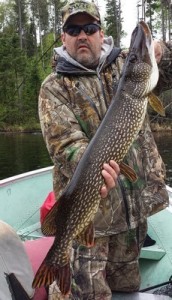 The #5 Mepps’ steady throb pulsed through the 30-pound Spiderwire, down the length of the medium/heavy-action graphite rod and directly into his hand. Just as the lure reached the edge of the cabbage weeds, the blade’s thrum came to an abrupt halt. He set the hook hard into what felt like a concrete wall! But then the wall began to move, and he knew he was into a trophy. Five minutes later and four desperate boatside runs, he lands the 20-pound northern pike.
The #5 Mepps’ steady throb pulsed through the 30-pound Spiderwire, down the length of the medium/heavy-action graphite rod and directly into his hand. Just as the lure reached the edge of the cabbage weeds, the blade’s thrum came to an abrupt halt. He set the hook hard into what felt like a concrete wall! But then the wall began to move, and he knew he was into a trophy. Five minutes later and four desperate boatside runs, he lands the 20-pound northern pike.
IT’S SIMPLE: Big pike LOVE spinners!
Weeds are the keys to spinning big pike crazy as these predators use vegetation to ambush any aquatic creature smaller than themselves.
The Baits
Spinner choices abound, but not all are created equal when it comes to enticing jumbo “scissorbills.” The angler should select certain sizes, shapes, and colors, over others.
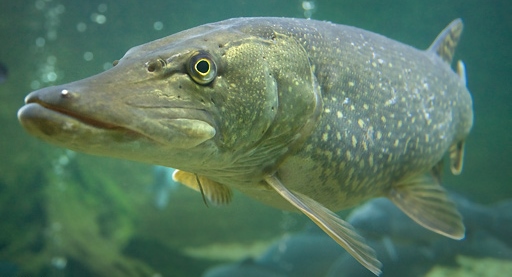 Lesson No. 1 in choosing spinners for Esox lucius: bigger always is better. Pick magnum-sized offerings as even hammer-handles attack huge lures with abandon, and to catch true monsters, you MUST have that big profile.
Lesson No. 1 in choosing spinners for Esox lucius: bigger always is better. Pick magnum-sized offerings as even hammer-handles attack huge lures with abandon, and to catch true monsters, you MUST have that big profile.
Fat, deeply cupped blades throw out big vibrations that ring the dinner bell for monster pike. While sometimes thinner shaped blades (such as willow-leafs) that spin faster turn the trick; usually the slower-turning Colorado-type blades prove to be the ticket to a pike bonanza.
Because big flash stimulates lunkers, polished silver and gold blades work great. Another killer color combo, especially for use in darker, stained water, is orange blades with a black trailer.
In-Line vs. Offset Spinners
Spinners for northerns come in two basic designs, and both work effectively, but each has its strengths and weaknesses.
In-line spinners (such as Mepps, Worden’s Lures Rooster Tails, Panther Martin, and Blue Fox’s Vibrax), with their terminal trebles, have higher hook-up and catch rates than their safety-pin brethren, but they also hook vegetation and other underwater structure, too.
But lures such as Terminators and Stanley Jigs’ Rick Clunn 4-Blade Willow Spinnerbaits, with their single, upturned hooks surrounded by manmade skirts, slither through the weeds, logs and stumps. In-lines also cast like bullets, while offsets can catch the wind and lose momentum.
Line, Leaders
Any of the new “super-lines” such as like Berkley FireLine, Spiderwire Fusion, or Remington’s Power-Lokt, are superior to monofilament for spinning pike angling. Their low stretch and high-abrasion resistance benefit pike anglers.
Flout the convention and tie on a snap/swivel instead of a leader. Leaders inhibit action and deter wary trophies, while the snap swivels provide two major benefits: quick lure changes and eliminating/reducing line twist. True, you’ll lose lures to the razor-sharp choppers of aggressive mounters, but you’ll get lots more bites without leaders!
Speed & Delivery
Often northerns will attack even jet-powered offerings, but slowing down, pausing, or herky-jerkying that spinner, especially when it reaches the “Pike Zone,” reaps big rewards. Even lazy fish will smash a spinnerbait dangled in front on their out-sized mouth.
Always cast beyond where you think the pike lurk, because while “scissorbills” are legendary for their aggressiveness, they don’t like being bombed. Landing a bait on top of one’s head will likely result in spooking it.
Spin-Crazy Times & Spots
Primetime for driving pike spin crazy depends upon the season, time of day, and prevailing weather conditions. Early spring, right after ice out, brings spawned out northern pike shoreward (where they’re most vulnerable). Spinner rigs elicit savage strikes from hungry pike during spring.
Because northerns sight-feed, mid-day piking makes sense. Following that logic, clear, blue-sky days with lots of sun create perfect pike angling weather.
 The spinner’s flash and large profile, easily visible to cruising whoppers, prove irresistible.
The spinner’s flash and large profile, easily visible to cruising whoppers, prove irresistible.
Look for incoming streams or rivers, and concentrate your efforts just off the edges of weedy drop-offs. Weeds are the keys to spinning big pike crazy, as these predators use vegetation to ambush any aquatic creature smaller than themselves. Position the boat on the deep side of the drop-off, and cast the spinner up onto the flat itself, cranking just fast enough to keep the lure above the weeds, and pause when you get to the weed edge. Allow the bait to drift down and find the waiting lunkers, and hang on!
Using spinners to drive northern pike stir crazy is fun, easy, and productive.
Follow our HUNTING BLOG
WEB RATES FISH HUNT CABINS PHOTOS